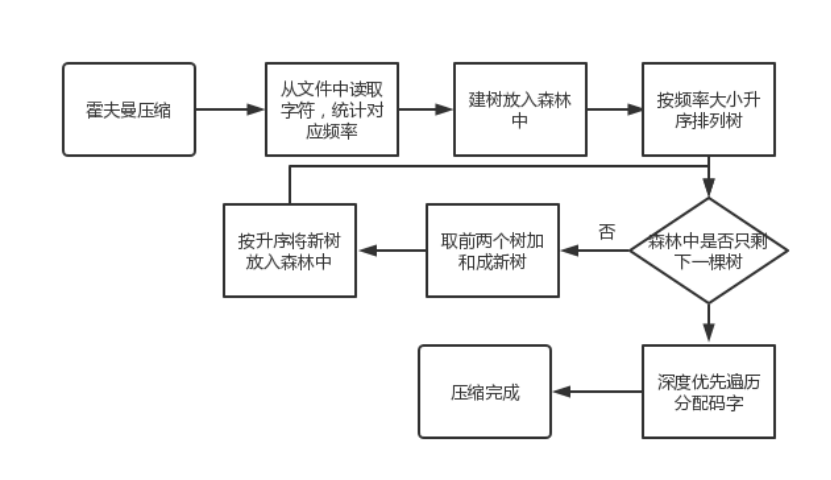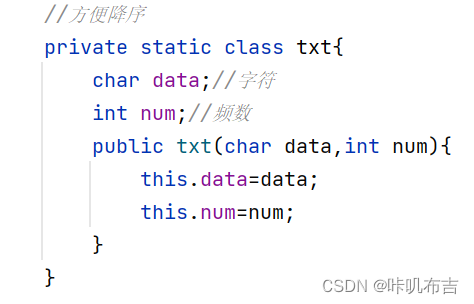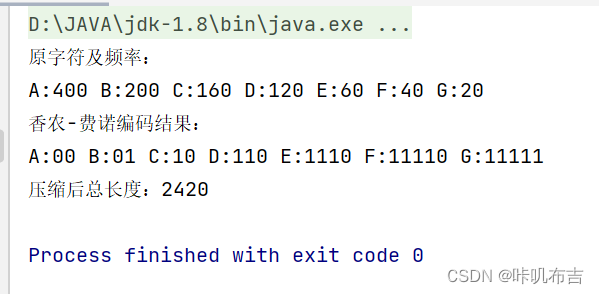一、霍夫曼编码
1.算法分析
霍夫曼编码是变长编码的一种,该方法完全依据字符出现概率来构造异字头的平均长度最短的码字,有时称之为最佳编码。
霍夫曼编码的具体步骤如下:
1)将信源符号的概率升序排队。
2)把两个最小的概率相加,形成一个新的概率集合,并继续这一步骤,始终将较高的概率分支放在右边,直到最后变成概率1。
3)画出由概率1处到每个信源符号的路径,顺序记下沿路径的0和1,所得就是该符号的霍夫曼码字。
4)将每对组合的左边一个指定为0,右边一个指定为1(或相反)。
2.题目解析
1.数据结构:
提到霍夫曼编码必须要提到霍夫曼树,所以首先要定义树:节点存放字符与权重(即字符出现次数),还要有左右两个孩子,考虑到最后分配码字的过程,还可以加上深度优先遍历的实现函数。数据结构如下:

2.实现过程:
首先是获取字符,我采用txt文件的方式存储字符串(直接输入读取更简单所以我介绍这种方式),读取过程中直接统计字符与其出现次数,存储在Map中。
然后开始建树,将Map中的字符与频率建成哈夫曼树节点,然后存放在链表LinkedList中;再将链表中的树节点按权重大小升序排列。
开始循环遍历,每次取出最小的两个树节点(也就是在链表中前两个),加和后成为新树,链接上左右两个子树,再按升序放回链表,直至只剩一个树节点。
深度优先遍历分配码字即可。

运行结果如下:

二、香农-费诺编码
1.算法分析
步骤如下:
1.将信源符号按照其概率大小,从大到小排列;
2.将这一组信源符号分成概率之和尽可能接近或者相等的一组(即两组分别的概率和之间的差尽可能小!);
3.将上面一组符号编码成0,下面一组编码成1,反之亦可;
4.将已经分好的组重复步骤2,3,直到不能再进行分组为止;
5.从左到右一次写出码字。
2.题目解析
1.数据结构:
费诺编码我没有建树,因为要将所有字符按频率大小降序排列,为了方便排序,我设计了txt类,存储字符与频数,数据结构如下:

2.实现算法:
首先从文件中读取字符,步骤同上,存储在Map中;
将Map中存储的数据以txt的形式存储在链表中,降序排列;
再将频数转成频率(小数);
因为费诺编码要把所有信符分为两组,重复直至每组只剩下一个信号,所以选择递归实现:终止条件为只剩下一个信号(即开始等于结束);分成大小差不多的两部分:因为降序排列,所以从第一个开始,以前i个信符的频率和的二倍减总和的差为基准,最小的即为所求;然后进行左右递归。

运行结果如下:

三、算术编码
1.算法分析
算术编码的编码对象是一则消息或一个字符序列,其编码思路是将消息或字符序列表示成0和1之间的一个间隔上的一个浮点小数。 在进行算术编码之前,需要对字符序列中每个字符的出现概率进行统计,根据各字符出现概率的大小,将每个字符映射到[0 ,1]区间上的某个子区间中。然后,在利用递归算法,将整个字符序列映射到[0,1]区间上的某个间隔中。在进行编码时,只需从该间隔中任选一个小数,将其转化为二进制数。 符号序列越长,编码表示他的间隔就越小,表示这个间隔所需的二进制位数就越多,编码输出的码字就越长。
在进行编码过程中,随着信息的不断出现,子区间按下列规律减小:
a.新子区间左端=前子区间左端+当前子区间左端×前子区间长度
b.新子区间长度=前子区间长度×当前子区间长度
2.题目解析
1.数据结构:定义qujian类存储区间前后端;
2.实现过程:
首先读取字符串,统计每个字符的上下端点。然后按照公式进行计算直至算到最后一个字符;最转换成二进制取公共部分,忽略0. 即可完成编码。
编码结果如下:


四、比较分析
1.霍夫曼编码特点:
1.Huffman码的编码方法保证了概率大的符号对应短码,概率小的符号对应长码,而且短码得到充分利用。
2.每次缩减信源的最后两个码字总是最后一位码元不同,前面各位码元相同(二元编码情况)。
3.每次缩减信源的最长两个码字有相同的码长。
这三个特点保证了所得的Huffman码一定是最佳码。
4.霍夫曼编码是无损压缩中效率较高的一种编码方式,但压缩过程复杂,运算量大。
2.香农费诺编码特点:
1.香农费诺编码考虑了信源的统计特性,使概率大的信源符号能对应码长较短的码字,从而有效地提高了编码效率。
2.香农费诺编码不一定是最佳码。因为香农费诺编码方法不一定能使短码得到充分利用。当信源符号较多时,若有一些符号概率分布很接近,分两大组的组合方法就会很多。可能某种分大组的结果,会使后面小组的“概率和”相差较远,从而使平均码长增加。
3.香农费诺编码相较于霍夫曼编码更加方便、快捷。
3.算术编码特点:
1.算术编码是比霍夫曼编码的压缩性能更优的一种变长编码方式,,可以采用比霍夫曼编码更少的码字。
2.算术编码的实现方法比霍夫曼更复杂,但是编码效率高。
4.结果比较:
霍夫曼编码:

香农-费诺编码:

可见,香农费诺<霍夫曼。
对于相同字符串,三种方式的编码结果:



可见霍夫曼编码效率小于算术编码,而香农-费诺编码的压缩效率不一定好。
五、代码
代码文件目录:

arithmetic.java
package Arithmetic;
import java.io.*;
import java.util.HashMap;
import java.util.Map;
import java.util.Optional;
/**
* Description:
* date: 2022/4/9 16:10
*
* @author 颜霸灿烈
*/
public class arithmetic {
static int sum =0;
static StringBuffer s=new StringBuffer();
private static class qujian{
double start=0.0;
double end=0.0;
qujian(double start,double end)
{
this.start=start;
this.end=end;
}
}
static Map<Character,qujian> data=new HashMap<>();
static Map<Character,Integer>txts;
//字符串直接给
public static Map<Character,Integer> read(){
Map<Character,Integer> res=new HashMap<>();
res.put('A',400);
res.put('B',200);
res.put('C',160);
res.put('D',120);
res.put('E',60);
res.put('F',40);
res.put('G',20);
sum=1000;
qujian q1=new qujian(0,0.4);
data.put('A',q1);
qujian q2=new qujian(0.4,0.6);
data.put('B',q2);
qujian q3=new qujian(0.6,0.76);
data.put('C',q3);
qujian q4=new qujian(0.76,0.88);
data.put('D',q4);
qujian q5=new qujian(0.88,0.94);
data.put('E',q5);
qujian q6=new qujian(0.94,0.98);
data.put('F',q6);
qujian q7=new qujian(0.98,1);
data.put('G',q7);
System.out.println("原字符及频率:");
for(char key:res.keySet())
{
int value=res.get(key);
System.out.print(key+":"+value+" ");
}
System.out.println();
return res;
}
//从文件中读取字符串
public static Map<Character,Integer> readtxt() throws IOException {
String fileName="src/code.TXT";
Map<Character,Integer> txts=new HashMap<>();
File file = new File(fileName);
FileInputStream fis = new FileInputStream(file);
InputStreamReader isr = new InputStreamReader(fis);
BufferedReader br = new BufferedReader(isr);
String line;
System.out.println("原字符串为:");
while((line = br.readLine()) != null){
System.out.println(line);
for (int i = 0; i < line.length(); i++) {
char tmp=line.charAt(i);
sum++;
s.append(tmp);
if(txts.containsKey(tmp))
{
int n=txts.get(tmp);
n++;
txts.put(tmp,n);
}
else
{
txts.put(tmp,1);
}
}
}
// for(char key : txts.keySet()){
// int value = txts.get(key);
// System.out.println(key+":"+value);
// }
br.close();
return txts;
}
//压缩
public static void compress() throws IOException {
txts=readtxt();
// qujian q1=new qujian(0,0.2);
// data.put('a',q1);
// qujian q2=new qujian(0.2,0.5);
// data.put('b',q2);
// qujian q3=new qujian(0.5,0.9);
// data.put('c',q3);
// qujian q4=new qujian(0.9,1.0);
// data.put('d',q4);
// String ss="bcadc";
double start=0;
double end=0;
for (char key:txts.keySet()) {
double fre=txts.get(key)*1.0/sum;
start=end;
end+=fre;
qujian tmp=new qujian(start,end);
data.put(key,tmp);
}
String ss=s.toString();
double L=0;
double H=1;
for (int i = 0; i < ss.length(); i++) {
char tmp=ss.charAt(i);
qujian qj=data.get(tmp);
double n=H-L;
H=L+qj.end*n;
L=L+qj.start*n;
}
String l=decimal2Binary(L);
String r=decimal2Binary(H);
StringBuffer res=new StringBuffer();
for (int i = 0; i < l.length(); i++) {
if(l.charAt(i)==r.charAt(i))
{
res.append(l.charAt(i));
}
else{
res.append('1');
break;
}
}
System.out.println("算术编码结果为"+res);
System.out.println("编码长度为"+res.length());
}
//纯小数十进制变二进制
public static String decimal2Binary(double value){
StringBuilder stringBuilder = new StringBuilder();
int count = 100; // 限制小数部分位数
double num = 0;
while (value > 0.0000000001) {
count--;
if (count == 0) {
return stringBuilder.toString();
}
num = value * 2;
if (num >= 1) {
stringBuilder.append(1);
value = num - 1;
} else {
stringBuilder.append(0);
value = num;
}
}
return stringBuilder.toString();
}
public static void main(String[] args) throws IOException {
compress();
}
}
Fano.java
package Fano;
import Huffman.HuffmanTree;
import java.io.*;
import java.util.*;
import static java.lang.Math.abs;
/**
* Description:
* date: 2022/4/8 21:07
*
* @author 颜霸灿烈
*/
public class Fano {
static int res=0;
static int cnt = 0; //
static int sum=0;//字符总数
static LinkedList<txt>datas;//存储降序频率
static Map<Character,String> fenocode=new HashMap<>();//存储最后的编码结果
//方便降序
private static class txt{
char data;//字符
int num;//频数
public txt(char data,int num){
this.data=data;
this.num=num;
}
}
public static Map<Character,Integer> read(){
Map<Character,Integer> res=new HashMap<>();
res.put('A',400);
res.put('B',200);
res.put('C',160);
res.put('D',120);
res.put('E',60);
res.put('F',40);
res.put('G',20);
sum=1000;
System.out.println("原字符及频率:");
for(char key:res.keySet())
{
int value=res.get(key);
System.out.print(key+":"+value+" ");
}
System.out.println();
return res;
}
//从文件中读取统计字符频率
public static Map<Character,Integer> readtxt() throws IOException {
String fileName="src/code.TXT";
Map<Character,Integer> txts=new HashMap<>();
File file = new File(fileName);
FileInputStream fis = new FileInputStream(file);
InputStreamReader isr = new InputStreamReader(fis);
BufferedReader br = new BufferedReader(isr);
String line;
System.out.println("原字符串为:");
while((line = br.readLine()) != null){
System.out.println(line);
for (int i = 0; i < line.length(); i++) {
char tmp=line.charAt(i);
sum++;
if(txts.containsKey(tmp))
{
int n=txts.get(tmp);
n++;
txts.put(tmp,n);
}
else
{
txts.put(tmp,1);
}
}
}
br.close();
return txts;
}
/*统计频率*/
static double getSum(LinkedList<Double> p, int begin, int end){
double sum = 0;
for(int i = begin ; i <= end ; i++){
sum += p.get(i);
}
return sum;
}
//递归实现
static void Fanocode(LinkedList<Double> p, int begin, int end, String code){
// 边界条件
if(begin >= end){
fenocode.put(datas.get(cnt).data,code);
cnt++;
return;
}
// 找到分界值
double sum = getSum(p,begin,end);
int index = -1; // 初值设定
double minNum = sum; // 设定最小值
double tempSum = 0; // 前几个的和
for(int i = begin ; i <= end ; i++){
tempSum += p.get(i);
if(abs(sum-2*tempSum) < minNum){
index = i; // 记录当前最小的值
minNum = abs(sum-2*tempSum); // 更新最小值
}
else{
break;
}
}
// 递归左边部分
Fanocode(p,begin,index,code+'0'); // 左边添加0
// 递归右边部分
Fanocode(p,index+1,end,code+'1'); //右边添加1
}
//实现压缩
public static void compressact() throws IOException {
//读取文件中的字符串
Map<Character,Integer>txts;
// txts=read();
txts=readtxt();
//降序排列
datas=new LinkedList<txt>();
for(char key:txts.keySet())
{
int value=txts.get(key);
txt tmp=new txt(key,value);
datas.add(tmp);
}
Collections.sort(datas,new Comparator<txt>(){
public int compare(txt a,txt b){
return (int) b.num-a.num;
}
});
//转化成频率
LinkedList<Double>p=new LinkedList<>();
for (int i = 0; i < datas.size(); i++) {
double fre=datas.get(i).num*1.0/sum;
p.add(fre);
}
String code="";
System.out.println("香农-费诺编码结果:");
Fanocode(p,0,txts.size()-1,code);
for(char key:fenocode.keySet())
{
String value=fenocode.get(key);
res+=(value.length()*txts.get(key));
System.out.print(key+":"+value+" ");
}
System.out.println();
System.out.println("压缩后总长度:"+res);
}
public static void main(String[] args) throws IOException {
compressact();
}
}
Huffman.java
package Huffman;
import java.io.*;
import java.util.*;
//代码仅供参考,不一定正确,有错误请指正!
public class Huffman{
static int res=0;
static HashMap<Character,String> CodingMap;
public static Map<Character,Integer> read(){
Map<Character,Integer> res=new HashMap<>();
res.put('A',400);
res.put('B',200);
res.put('C',160);
res.put('D',120);
res.put('E',60);
res.put('F',40);
res.put('G',20);
return res;
}
//从文件中读取统计字符频率
public static Map<Character,Integer> readtxt() throws IOException {
String fileName="src/code.TXT";
Map<Character,Integer> txts=new HashMap<>();
File file = new File(fileName);
FileInputStream fis = new FileInputStream(file);
InputStreamReader isr = new InputStreamReader(fis);
BufferedReader br = new BufferedReader(isr);
String line;
System.out.println("原字符串为:");
while((line = br.readLine()) != null){
System.out.println(line);
for (int i = 0; i < line.length(); i++) {
char tmp=line.charAt(i);
if(txts.containsKey(tmp))
{
int n=txts.get(tmp);
n++;
txts.put(tmp,n);
}
else
{
txts.put(tmp,1);
}
}
}
// for(char key : txts.keySet()){
// int value = txts.get(key);
// System.out.println(key+":"+value);
// }
br.close();
return txts;
}
//压缩编码
public static void compressact()throws IOException{
Map<Character,Integer>txts;
txts=read();
// txts=readtxt();
LinkedList<HuffmanTree> forest=new LinkedList<HuffmanTree>();
CodingMap=new HashMap<>();
System.out.println("字符及频率如下:");
//建树
for(char key : txts.keySet()){
int value = txts.get(key);
forest.add(new HuffmanTree(value,key));
System.out.print(key+":"+value+" ");
}
System.out.println("");
Collections.sort(forest,new Comparator<HuffmanTree>(){
public int compare(HuffmanTree a, HuffmanTree b){
return (int) (a.weight-b.weight);
}
});//排序
while(forest.size()>1){
HuffmanTree a = forest.removeFirst();
HuffmanTree b = forest.removeFirst();//取出前两个
HuffmanTree c = new HuffmanTree(a.weight+b.weight);//增加新的节点
c.lChild=a;//连接ac
c.rChild=b;//连接bc
int index=0;//用来记录应该插入的位置
for(;index<forest.size();index++) {
if (forest.get(index).weight >= c.weight) {
forest.add(index, c);
break;
}
}
//如果森林里没有比它大的,则插在末尾
if(index>= forest.size())
forest.add(index,c);
}
HuffmanTree result=forest.get(0);
result.dfs(CodingMap,"");
System.out.println("霍夫曼编码结果如下:");
for(char key : CodingMap.keySet()){
String value = CodingMap.get(key);
res+=(value.length()*txts.get(key));
System.out.print(key+":"+value+" ");
}
System.out.println();
System.out.println("压缩后总长度:"+res);
}
public static void main(String[] args) throws IOException {
compressact();
}
}
HuffmanTree.java
package Huffman;
import java.util.HashMap;
/**
* Description:
* date: 2022/4/8 19:35
*
* @author 颜霸灿烈
*/
public class HuffmanTree{
public int weight;//出现频率
public char data;//字符
public HuffmanTree lChild,rChild;//左右两个还在
public HuffmanTree(int weight){
this.weight=weight;
}//构造函数
public HuffmanTree(int weight,char data){
this.weight=weight;
this.data=data;
}
/*深度优先遍历分配码字*/
public void dfs(HashMap<Character,String> cm, String prefix){
int count=0;//记录有几个孩子
if(lChild!=null){
lChild.dfs(cm,prefix+"0");
//左孩子边为0
count++;//有一个孩子
}
if(rChild!=null){
rChild.dfs(cm,prefix+"1");
//右孩子边为1
count++;//有两个孩子
}
if(count==0){//一个孩子都没有,叶子节点
cm.put(data,prefix);
}
}
}
最后
以上就是自觉雪糕最近收集整理的关于数字图像处理:压缩编码的全部内容,更多相关数字图像处理内容请搜索靠谱客的其他文章。








发表评论 取消回复